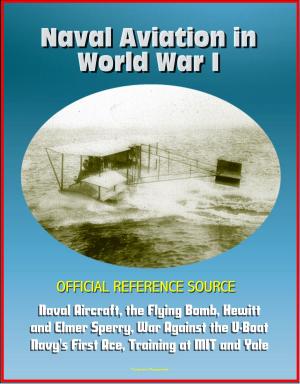Beyond Horizons: A Half Century of Air Force Space Leadership, Military Space Programs, Sputnik through the Age of Apollo and the Gulf War
Nonfiction, Science & Nature, Technology, Aeronautics & Astronautics, Military Science| Author: | Progressive Management | ISBN: | 9781476056050 |
| Publisher: | Progressive Management | Publication: | March 21, 2012 |
| Imprint: | Smashwords Edition | Language: | English |
| Author: | Progressive Management |
| ISBN: | 9781476056050 |
| Publisher: | Progressive Management |
| Publication: | March 21, 2012 |
| Imprint: | Smashwords Edition |
| Language: | English |
Beyond Horizons: A Half Century of Air Force Space Leadership is a study of the United States Air Force in space. Of all the military services, the Air Force has been preeminently involved for the past fifty years in initiating, developing, and applying the technology of space-based systems in support of the nation's national security. Yet there has been no single-volume overview of the Air Force space story to serve as an introduction and guide for interested readers. In November 1992, a high-level Air Force Blue Ribbon Panel on Space, chaired by then Lieutenant General Thomas S. Moorman, Jr., commander of Air Force Space Command, concluded there was a specific need to better educate people, both in the service and among the general populace, about the history of Air Force space activities. Beyond Horizons has been written to meet this need.
Beyond Horizons begins with a review of pre-World War II rocketry developments and the forging of the important partnership between the Army Air Forces' Chapter 1 focuses on space and missile efforts prior to the launch of the Soviet Sputnik satellites in late 1957. Beginning with analysis of the Rand satellite report, the chapter examines the policy, organizational, and funding constraints, based largely on inter- and intra-service rivalries, that Air Force missile and space advocates had to overcome during the late 1940s and early 1950s in order to establish an effective enterprise. In a sense, the Air Force entered the space age on the coattails of intercontinental ballistic missile (ICBM) development and President Dwight D. Eisenhower's determination to protect the nation from surprise attack.
Chapter 2 focuses on the important policy and organizational steps taken after Sputnik which helped the Air Force achieve leadership of the nation's military space activities. Initial Air Force hopes of leading a national space program ended with the establishment of the National Aeronautics and Space Administration (NASA).
Chapter 3 describes Air Force efforts to achieve a dominant role in space through its support of NASA and its attempts to acquire a military manned spaceflight mission and approval for development of space-based weapons.
Despite the seemingly bleak outlook for an Air Force space future by the early 1970s, however, two developments would reinvigorate the Air Force space program—the success of instrumented satellites and the Space Shuttle.
Chapter 4 examines the Air Force's leadership role in the emergence of artificial earth satellites during the 1960s for communications, navigation, meteorology, and surveillance and reconnaissance.
Chapter 5 discusses the complex interplay of space policy, organizational, and operational issues that culminated in the formation of the Air Force's Space Command.
Chapter 6 describes the efforts of Air Force Space Command in the 1980s to consolidate its control over space systems and move the Air force from an "operational agenda" for space to the creation of an "operational mindset" for space.
Chapter 7 focuses on the role of space in the Persian Gulf War in early 1991. This conflict represented the coming of age of military space by demonstrating the value of an "operational mindset" for space.
Contents: CHAPTER 1 - Before Sputnik: The Air Force Enters the Space Age, 1945-1957 * CHAPTER 2 - From Eisenhower to Kennedy: The National Space Program and the Air Force's Quest for the Military Space Mission, 1958-1961 * CHAPTER 3 - The Air Force in the Era of Apollo: A Dream Unfulfilled * CHAPTER 4 - From the Ground Up: The Path from Experiment to Operations * CHAPTER 5 - Organizing for Space: The Air Force Commits to Space and an Operational Space Command * CHAPTER 6 - From Star Wars to the Gulf War: The Air Force Moves to Create an Operational Capability for Space * CHAPTER 7 - Coming of Age: Operation Desert Storm and Normalizing Military Space Operations * CHAPTER 8 - An Air Force Vision for the Military Space Mission
Beyond Horizons: A Half Century of Air Force Space Leadership is a study of the United States Air Force in space. Of all the military services, the Air Force has been preeminently involved for the past fifty years in initiating, developing, and applying the technology of space-based systems in support of the nation's national security. Yet there has been no single-volume overview of the Air Force space story to serve as an introduction and guide for interested readers. In November 1992, a high-level Air Force Blue Ribbon Panel on Space, chaired by then Lieutenant General Thomas S. Moorman, Jr., commander of Air Force Space Command, concluded there was a specific need to better educate people, both in the service and among the general populace, about the history of Air Force space activities. Beyond Horizons has been written to meet this need.
Beyond Horizons begins with a review of pre-World War II rocketry developments and the forging of the important partnership between the Army Air Forces' Chapter 1 focuses on space and missile efforts prior to the launch of the Soviet Sputnik satellites in late 1957. Beginning with analysis of the Rand satellite report, the chapter examines the policy, organizational, and funding constraints, based largely on inter- and intra-service rivalries, that Air Force missile and space advocates had to overcome during the late 1940s and early 1950s in order to establish an effective enterprise. In a sense, the Air Force entered the space age on the coattails of intercontinental ballistic missile (ICBM) development and President Dwight D. Eisenhower's determination to protect the nation from surprise attack.
Chapter 2 focuses on the important policy and organizational steps taken after Sputnik which helped the Air Force achieve leadership of the nation's military space activities. Initial Air Force hopes of leading a national space program ended with the establishment of the National Aeronautics and Space Administration (NASA).
Chapter 3 describes Air Force efforts to achieve a dominant role in space through its support of NASA and its attempts to acquire a military manned spaceflight mission and approval for development of space-based weapons.
Despite the seemingly bleak outlook for an Air Force space future by the early 1970s, however, two developments would reinvigorate the Air Force space program—the success of instrumented satellites and the Space Shuttle.
Chapter 4 examines the Air Force's leadership role in the emergence of artificial earth satellites during the 1960s for communications, navigation, meteorology, and surveillance and reconnaissance.
Chapter 5 discusses the complex interplay of space policy, organizational, and operational issues that culminated in the formation of the Air Force's Space Command.
Chapter 6 describes the efforts of Air Force Space Command in the 1980s to consolidate its control over space systems and move the Air force from an "operational agenda" for space to the creation of an "operational mindset" for space.
Chapter 7 focuses on the role of space in the Persian Gulf War in early 1991. This conflict represented the coming of age of military space by demonstrating the value of an "operational mindset" for space.
Contents: CHAPTER 1 - Before Sputnik: The Air Force Enters the Space Age, 1945-1957 * CHAPTER 2 - From Eisenhower to Kennedy: The National Space Program and the Air Force's Quest for the Military Space Mission, 1958-1961 * CHAPTER 3 - The Air Force in the Era of Apollo: A Dream Unfulfilled * CHAPTER 4 - From the Ground Up: The Path from Experiment to Operations * CHAPTER 5 - Organizing for Space: The Air Force Commits to Space and an Operational Space Command * CHAPTER 6 - From Star Wars to the Gulf War: The Air Force Moves to Create an Operational Capability for Space * CHAPTER 7 - Coming of Age: Operation Desert Storm and Normalizing Military Space Operations * CHAPTER 8 - An Air Force Vision for the Military Space Mission















